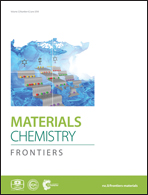Generating a three-dimensional non-fullerene electron acceptor by combining inexpensive spiro[fluorene-9,9′-xanthene] and cyanopyridone functionalities†
Abstract
Through the combination of cheaply synthesized structural fragments, spiro[fluorene-9,9′-xanthene] – otherwise termed low-cost spiro – and cyanopyridone, herein we report a new, three-dimensional, small molecule non-fullerene electron acceptor, (5Z,5′Z,5′′E,5′′′E)-5,5′,5′′,5′′′-((((S)-spiro[fluorene-9,9′-xanthene]-2,2′,7,7′-tetrayl)tetrakis(thiophene-5,2-diyl))tetrakis(methaneylylidene))tetrakis(4-methyl-1-octyl-2,6-dioxo-1,2,5,6-tetrahydropyridine-3-carbonitrile) [A1], which was synthesized for use in solution-processable bulk-heterojunction devices and was fully characterized by proton and carbon NMR spectroscopies together with elemental analysis. A1 was synthesized by a facile synthetic methodology using a Knoevenagel condensation reaction and was found to be highly soluble in a variety of common processing solvents such as chloroform and o-dichlorobenzene. Owing to its envisioned design, A1 displayed promising optoelectronic properties, and energy levels complementing those of the conventional donor polymers poly(3-hexylthiophene) [P3HT] and poly({4,8-bis[(2-ethylhexyl)oxy]benzo[1,2-b:4,5-b′]dithiophene-2,6-diyl}{3-fluoro-2-[(2-ethylhexyl)carbonyl]-thieno[3,4-b]thiophenediyl}) [PTB7]. Given its energy levels, solubility and excellent film forming capability, A1 was used in bulk-heterojunction devices as an n-type semiconducting component. The device performances [D : A 1 : 1.2 = 5.84% (P3HT); 7.21% (PTB7)] validated the design and use of A1 as an efficient non-fullerene acceptor.
![Graphical abstract: Generating a three-dimensional non-fullerene electron acceptor by combining inexpensive spiro[fluorene-9,9′-xanthene] and cyanopyridone functionalities](/en/Image/Get?imageInfo.ImageType=GA&imageInfo.ImageIdentifier.ManuscriptID=C8QM00067K&imageInfo.ImageIdentifier.Year=2018)


 Please wait while we load your content...
Please wait while we load your content...
